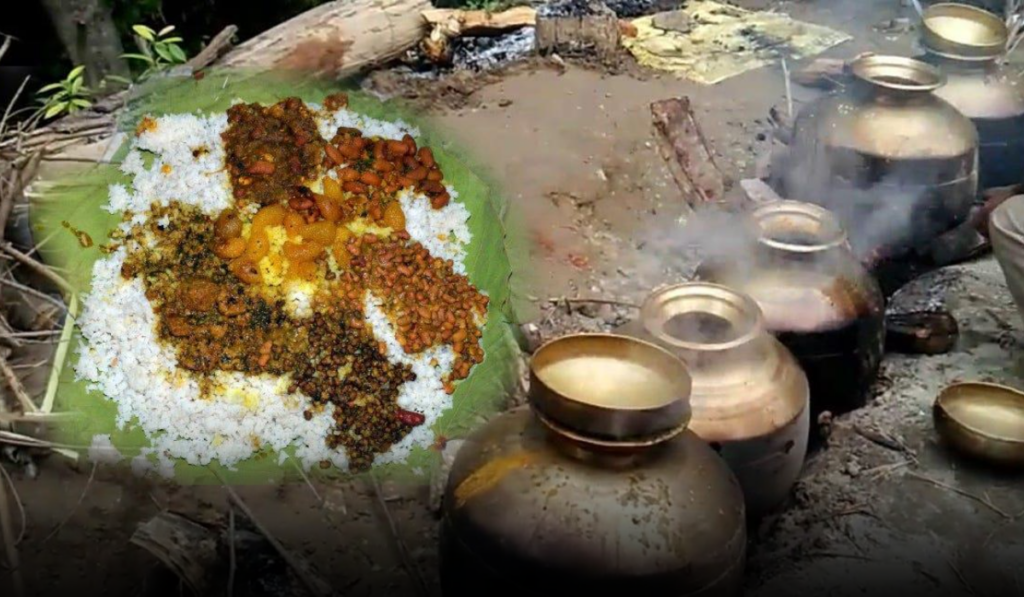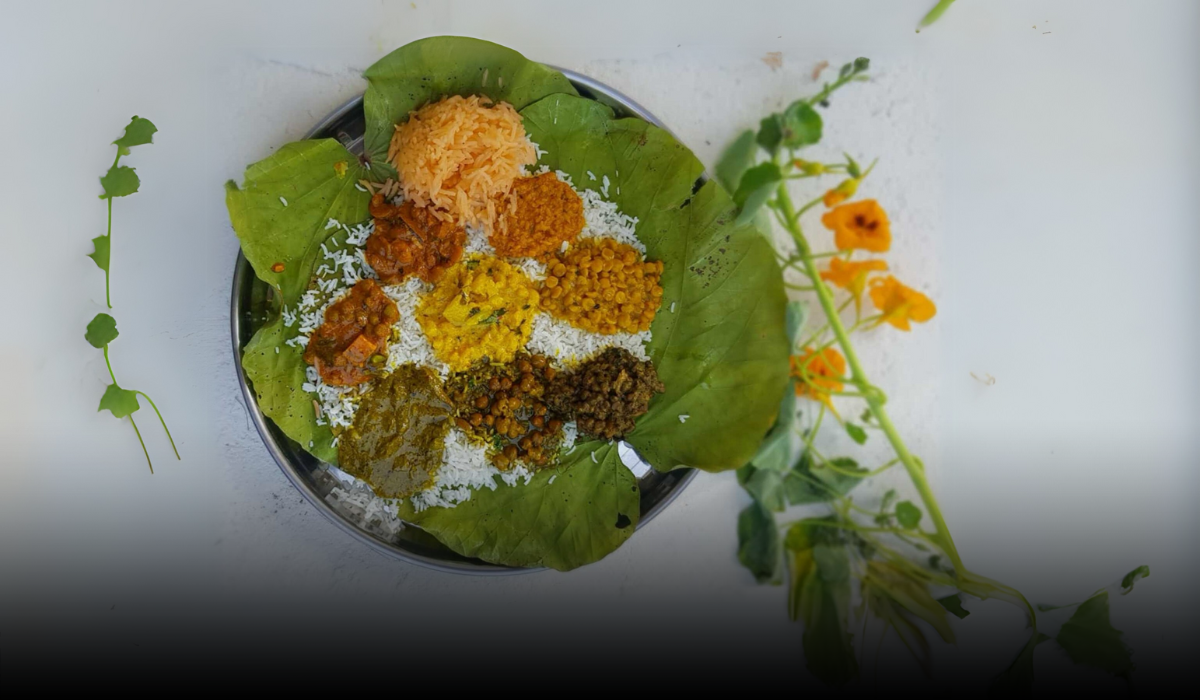Himachali Dham is more than just a meal—it is a traditional feast that honors culture and the richness of taste over generations. The beautiful hill state of Himachal Pradesh gave birth to this feast as a part of festivals, marriage ceremonies, and temple rituals. While meals eaten in everyday lives differ, Himachali Dham is specifically prepared and presented. It thus remains one of the most distinct feasts from India. It reflects the hospitality and warmth of the Himachali people, who take great pride in serving this grand meal to guests.
The Tradition Behind Himachali Dham
Himachali Dham holds immense cultural and religious values. Traditionally prepared by the Brahmin chefs, who practice a specific community called Botis / Rasoiya, mainly in the expertise of this elaborate meal cooking, the food is onionless and garlicless—that is, it is sattvic, meaning pure in Hindu tradition—and served on leaf plates, giving it its authentic and eco-friendly appeal.
People would sit in lines for a great distance while multiple courses of Himachali Dham are offered to them on such occasions as weddings and festivals, thus making the atmosphere of dining shared and spiritual in nature. That is not done just for having the flavors, but to inculcate an idea of integration and unity among the diners. Each small region of Himachal would have slight alterations of the food, but still, the sense is the same.
What Makes Himachali Dham Unique?
Himachali Dham is distinguished by local ingredients, slow-cooked flavors, and a traditionalist serving style. Compared with other Indian feasts, it is strictly vegetarian and prepared in brass utensils that add to the flavor. The food is also well balanced in terms of sour, spicy, and rich flavors. Curd, tamarind, and lentils constitute the most primary ingredients.
Unique Features:
- No onion and garlic: This makes it different from almost all other regional Indian cuisines, which is light on the stomach yet full of flavor.
- Use of curd-based gravies: Many of the dishes are prepared with curd, like Madhra. This gives the dish a smooth texture and an exclusive tangy taste.
- Cooked in brass utensils: The slow-cooked food in traditional utensils enhances the earthy, original flavors of the dishes and spices’ aroma.
- Eco-friendly serving style: It is served on leaf plates, contributing to its traditional appeal and ease on the environment.
- A community feast: Unlike restaurant-styled food, Himachali Dham is more of a community affair with food being served in an organized manner, giving a united feeling.
Exploring Kangri Dham and Mandyali Dham: Regional Variations
The Himachali Dham is prepared differently in different regions. Kangri Dham, very popular in Kangra, and Mandyali Dham from Mandi are two of the most popular regional versions. The flavor and variety of dishes of each version enrich the overall Himachali Dham.

Differences Between Kangri and Mandyali Dham:
- Kangri Dham: Famous for its very mild yet full of flavor dish, it boasts a combination of lentil dishes such as Madhra, Sepu Vadi, and Khatta. Well-balanced flavour with a right amount of spice and curd-based gravies.
- Mandyali Dham: Tangier and spicier than Kangri Dham, this has Teliya Mah – urad dal cooked in mustard oil, Chana Dal, and a tadka of ghee. It gives the food a sharp robust flavor because it is cooked in mustard oil.
Popular Kangri Dham / Mandyali Dham Dishes You Must Try
- Madhra – A creamy, curd-based dish that includes chickpeas or lentils, and is slow-cooked with spices.
- Sepu Vadi – Deep-fried lentil dumplings in a light and flavorful spinach-based gravy offering a healthy, protein-rich delicacy.
- Khatta – A tangy dish made using tamarind or dried mango powder, giving a perfect contrast to the rich and creamy dishes.
- Chana Dal with Yogurt and Ghee Tadka – It is creamy lentil and highly aromatic because it contains loads of ghee which makes this one delicious.
- Teliya Mah – A special type of urad dal preparation done in mustard oil, which will give a deeper and intense flavour.
Cooking Process and Unique Flavors of Himachali Dham
It takes time to prepare Himachali Dham because the dishes get a lot of flavor due to slow cooking in brass utensils.
- Slow cooking in brass utensils has a great taste and saves nutrients.
- No onion and garlic are used, preserving its pure taste in religious feasts.
- Curd-based gravies and mustard oil cooking bring a distinct richness, making the food both delicious and easy to digest.
- It brings depth to flavors and contributes towards nutritional value if freshly ground spices and local pulses are used in the preparation.
Also Read: Taste the Flavors of Dharamshala Traditional Food and Local Delights
Himachali Dham Serving Process
Himachali Dham is so unique with a traditional method of serving each delicacy. This meal is served step by step on a banana or leaf plate as each dish is introduced at its given stage of serving. Serving style:
- The guests sit in long rows on mats and share a sense of community.
- It is the curd-based preparation Madhra, that begins the meal on a rich and flavorful note
- This is followed by Sepu Vadi and Chana Dal, offering a mix of protein-rich dishes.
- Khatta is served afterward to add the tanginess and enhance digestion.
- Teliya Mah is followed by other daals combined, and the meal is ensured to be well-balanced and fulfilling with those dishes.
- It is ended by Meetha Bhaat (sweet rice), a perfect dessert to take off with some sweetness in your meal.
All dishes are set so that all complement each other in order, so that everything complements together.
Where Can You Experience Authentic Himachali Dham?
If you want the real taste of Himachali Dham, then visit these places:
- Temples: Religious feasts held in temples during festivals like Dussehra and Janmashtami offer authentic Dham.
- Traditional Weddings: Most Himachali marriages have Dham mainly served. The guests are provided with many dishes of authentic taste.
- Local Eateries: Some restaurants in Kullu, Kangra, and Mandi offer Dham. These are usually prepared by professional chefs who are well aware of the traditional method of cooking.
- Festivals and Fairs: The Minjar Mela at Chamba has many festivals which serve Dham to both locals and tourists in their most authentic forms.
Conclusion
Himachali Dham is beyond just being a meal—it’s a rich cultural experience of connecting with Himachal Pradesh’s glorious history. Be it the handpicked ingredients, traditional age-old recipes, or its religious importance. This feast of Himachali Dham happens to be India’s most authentic food culture in every aspect. Its other sub-types include Kangri Dham and Mandyali Dham, making the list endless in diversity. If you have not had it yet, make sure to add this to your food bucket list!
FAQ’s
What makes Himachali Dham different from other Indian feasts?
Himachali Dham is onion and garlic-free, served on leaf plates, and made with a traditional slow-cooked method that deepens flavors.
Can I find Himachali Dham in restaurants?
Yes, authentic Himachali Dham is served at some traditional eateries in Kullu, Kangra, and Mandi.
What is the most popular dish in Himachali Dham?
The most loved dish here is Madhra, a curd-based dish with chickpeas or lentils.
Why is brass used for cooking Himachali Dham?
Slow cooking in brass utensils helps to enhance flavors and makes food taste better.








